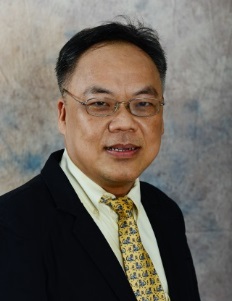Keynote Speaker

Dr. Eddie Y. K. Ng
PhD, PGDTHE, FEASA [EU], FASME [USA], FNAT [USA], FIETI [HK], FIET [UK], DFIDSAI [CN], Nanyang Technological University, SingaporeSpeech Title: DEVELOPMENT OF PHOTOPLETHYSMOGRAPHY (PPG) ANALYSIS TOOL WITH HEART RATE VARIABILITY THROUGH POINCARE AND SEQUENCE BANDWIDTH ASSESSMENT
Abstract: As the number of people affected by cardiovascular diseases (CVD) increases each year with hypertension, maintaining of blood pressure levels becomes crucial. Traditionally, it was done using sphygmomanometer which is the clinical standard for measurement. However, the method has proven to be impractical due to the lack of constant monitoring and convenience. Many researchers have thus investigated Photoplethysmography (PPG) wearable technologies in search for a better alternative. The wearables that are currently available such as smartwatches have demonstrated to be relatively inaccurate with motion and noise artifacts and they are not suitable for the adoption in healthcare applications with the lack of clinical information. Hence, there is significant need to develop a technique in obtaining accurate and useful clinical information from PPG.
This talk presents the development of a PPG analysis tool with the assessment of Heart Rate Variability (HRV). With a prototype that was developed in-house, data collection of ECG and PPG signals alongside heart rates and blood pressures using a blood pressure monitor was carried out. Subsequently, a simple yet accurate original window extraction algorithm was developed to carefully select and extract proper PPG waveforms to be used for analysis. The process included signal pre-processing, filtering, feature detection, window extraction and signal reconstruction. Following that, various measures of HRV such as time domain, frequency domain, non-linear (Poincaré) and its bandwidth were extracted to better analyse the PPG signals. The main focus of the study was to evaluate and analyse PPG through Poincaré and HRV sequence bandwidth. These 2 measures were used for analysis due to their potential significance in providing clinical usefulness and possibility of a new breakthrough. Lastly, a Graphical User Interface (GUI) application was designed to provide easy viewing of a summary of the HRV analysis.
Biography:
Eddie is elected as:
* Academician for European Academy of Sciences and Arts (EASA, EU);
* Fellow of the American Society of Mechanical Engineers (FASME, USA);
* Fellow (inaugural) for National Academy of Technology (FNAT, USA);
* Fellow of Institute of Engineering and Technology (FIET, United Kingdom);
* Fellow of International Engineering and Technology Institute (FIETI, Hong Kong);
* Distinguished Fellow for Institute of Data Science and Artificial Intelligence, (DFIDSAI, China);
* Academician for Academy of Pedagogy and Learning, (USA).
He has published numerous papers in SCI-IF int. journal (430); int. conf. proceedings (130), textbook chapters (>105) and others (32) over the 29 years. Co-edited 14 books in STEM areas.
He is in the Stanford list of the World’s top 2% Scientists since 2019 (ranked 173 as 0.001% in the field of Biomedical Engineering), and ranked # 8 (Worldwide) in Google Scholar under Biomedical, cited by 14504 (h-index: 62).
He is the:
* Lead Editor-in-Chief for the ISI Journal of Mechanics in Medicine and Biology for dissemination of original research in all fields of mechanics in medicine and biology since 2000;
* Founding Editor-in-Chief for the ISI indexed Journal of Medical Imaging and Health Informatics;
* Associate editor or EAB of various referred international journals such as Applied Intelligence, BioMedical Engineering OnLine, Computers in Biology & Medicine, and, Journal of Advanced Thermal Science Research.
More details can be found in: Cv: https://dr.ntu.edu.sg/cris/rp/rp00847.
Ng obtained Ph.D. at Cambridge Univ. and elected as an Academician for European Academy of Sciences and Arts, a Fellow of The American Society of Mechanical Engineers; The Institution of Engineering and Technology [UK], and International Engineering & Technology Institute [HK]. He researches in numerical simulation in the biomedical engineering, thermal-fluids and health-related diagnosis fields. He is Editor-in-Chief for 2 ISI-journals which were captured by the JCR within 2-years of their inauguration. He has been recognized internationally for academic excellence. He received numerous best papers, service awards and has graduated 23 PhD and 26 Master students. He was awarded the SPRING-Singapore Merit Award for his work in thermal imagers to screen SARS fever and contributions to the Singapore Standardization Program. Twenty-one of his papers have been adopted as references in Singapore Standard (SS-582, Parts 1&2: 2020) and ISO/IEC 80601-2-59: 2017. He serves as a panel member for Singapore Biomedical and Health Standards Committee since 2011. Being a co-inventor of 3 US patents on software classifiers to identify the different stages of breast cancer development in iTBra-system, he was accoladed with equity in a listed company. His ongoing work on non-contact screening for carotid artery stenosis and superficial vein-finder has resulted in 3 TDs. He has notable citations in the field of infrared physics & technology.
